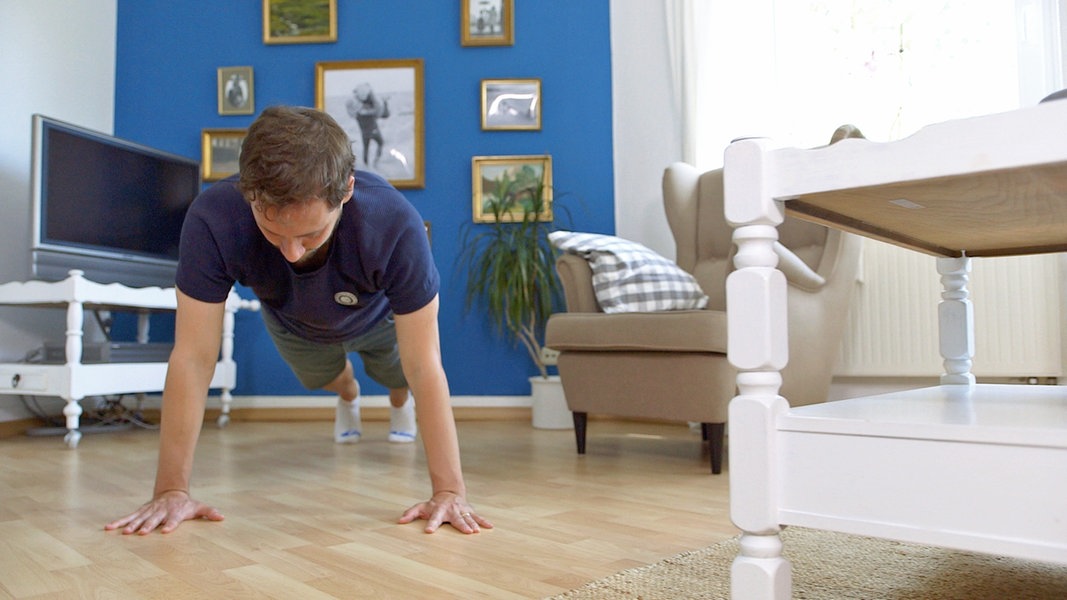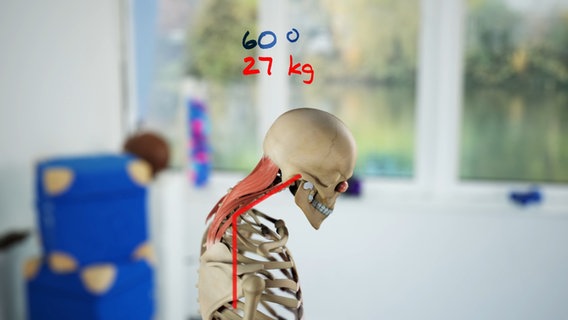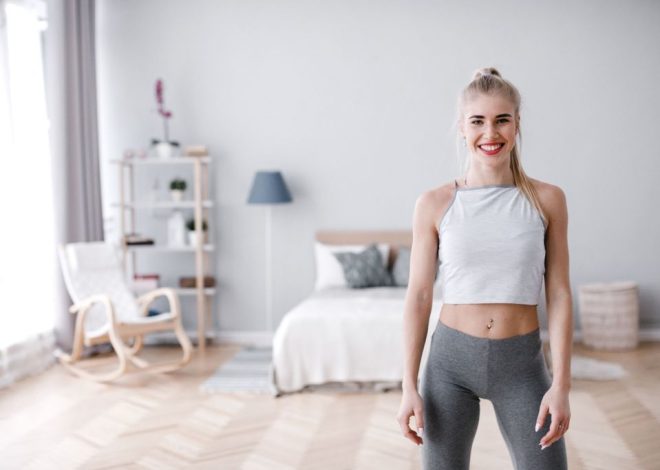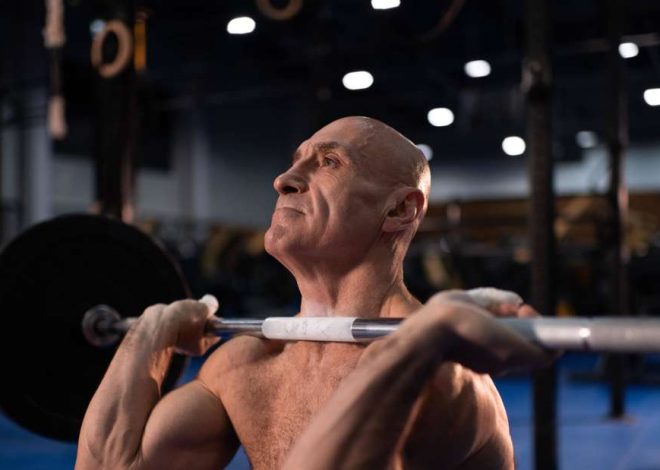
Fitness: Exercises for at home and in everyday life | NDR.de – Guide
Status: 28.05.2024 08:33 a.m.
| from
We can train strength, endurance and coordination in everyday life – without special equipment. Micro-workouts and fitness exercises can even replace cardio and strength training.
We don’t have to plan a lot of time and can do a lot for our fitness at home. This also prevents tension and bad posture. The exercise doctors give training tips for everyday life.
The best exercises for screen work

The head normally weighs four to five kilos. When tilted forward at 60 degrees, 27 kilos pull on the neck muscles.
Anyone who works a lot on a laptop spends several hours a day in a less ergonomic posture. “A laptop workstation is not ideal from an orthopedic point of view,” says rehabilitation physician Dr. Christian Sturm. Tension is inevitable because you sit in a monotonous, hunched-over position. Your head tilts downwards towards the screen, which puts strain on your shoulder and neck muscles.
This makes exercise all the more important. “Stand up once an hour and loosen up so that your upper body stops leaning forward,” recommends Sturm. “It’s best to set a reminder on your computer or cell phone to do this.”
- Shake yourself while standing, Pat your body as you please. Walk a few steps.
- Circle backwards with both arms – make large, soft, circular movements with your arms. Open up, gain space.
- Alternately circle your arms backwards – here too, large, soft movements.
- Stretching with a Theraband – stretch both arms out loosely and wrap the theraband around your hands, with your thumbs pointing upwards. Now pull your arms apart, or backwards if you like (alternatively, pull a rolled-up towel apart). Important: move your shoulders away from your ears.
Basic fitness: How often should you train?
“It’s best to do 15 minutes of stretching exercises every day,” says orthopedic surgeon Dr. Christian Sturm, “for example, first thing in the morning when you get up or in the evening while you’re watching the news.” Or do it in the kitchen in between – while the coffee is brewing or the tea is brewing.
In combination with this, the exercise doctors recommend half an hour of “core-active exercise” at least once or twice a week, i.e. targeted strengthening exercises for the back and abdominal muscles.
What if you don’t have time for sports?

Movement doctor Christian Sturm shows a simple but very effective stretching exercise for the neck.
“None of us have time. It is all the more important to make what we do anyway more active. A prime example: brushing your teeth while standing on one leg and doing balance exercises,” says sports doctor Dr. Helge Riepenhof. So incorporate exercise in between and on the side: walk around the apartment while you’re on the phone, do stretching or strengthening exercises while watching a crime drama. Even very simple, small exercises – such as rolling your shoulders backwards or tilting your head to the right and left – have shown enormous effects in studies when they are performed several times a day. What ultimately counts is the will to “see it through”.
Training time: What to do when your inner “lazy dog” speaks up?
Our inner laziness wants to make us believe that exercise is too strenuous. There are three things that can help against this.
1. A little exercise is better than none at all. Don’t set your goals too high at the beginning, it’s better to increase them slowly. On bad days, you can even do a shorter program. Because once you’ve started, you can usually achieve more than you thought.
2. Organize and create rituals: Make exercise a permanent part of your daily routine and link it to things you do anyway. For example, bounce on your toes and move your calves while brushing your teeth, or do a series of floor exercises every time you watch your favorite series. Be careful: it often takes a few weeks for a ritual to become established. But once exercise has become part of a routine, you do it automatically.
3. Reward: For some, just thinking about how good their body feels after exercise is enough to get them going. They feel pleasantly exhausted, pain disappears, they feel “like a new person”. Other people love to put a “done” cross in their calendar or treat themselves to something when they reach a goal. Rewards help to reinforce behavior.
WHow much space do you need?
Ideally, you have a place with enough space for you to lie down and stretch out your arms without hitting anything. But there are also countless exercises that you can do while sitting at your desk or wherever you are standing – stretches, for example, or exercises that train both strength and endurance.
Basic fitness: Which sports equipment is useful?
Basically, you don’t need to buy anything to get started. If you don’t have a carpeted room, you might want to get an exercise mat for stretching and strength exercises while lying down. Many effective exercises work with your body weight alone – without equipment or other aids. Otherwise, you can simply use water bottles instead of dumbbells as weights.
Further information
Once you’ve found the joy of training at home, you can add a lot more variety to your exercise program with a balance pad (wobble cushion) and therapy bands – both are inexpensive and space-saving fitness equipment. A swing bar can also enrich your training. It’s worth buying a fascia roller, especially for people with painful tension (a tennis ball will do the trick). Small but great for more endurance and coordination: a skipping rope.
What do beginners need to consider?
The basis should always be sufficient exercise in everyday life for basic fitness: “A good guideline is around 10,000 steps a day,” says cardiologist Dr. Melanie Hümmelgen. People with sedentary jobs who travel by car often barely achieve a quarter of this amount. Walking to the shops, taking the stairs instead of the escalator, taking a short walk now and then – such small changes add up to a big difference. “Every step, every single minute of exercise a day counts,” emphasizes exercise doctor Melanie Hümmelgen.
Micro-workouts instead of long training sessions
One trend is so-called micro-workouts. These are short, intensive exercises that can also be done anywhere and at any time. They usually last five to ten minutes and are done two to three times a day. They can also break up long periods of sitting in the office, for example, or end the day before going to bed.
Typical fitness exercises in a micro-workout include:
- Climb stairs
- Forearm support (plank)
- Squats
- Abdominal presses (crunches)
- Jumping Jacks
An example of a micro-workout: five sets of 40-second squats, with a 20-second break in between.
Perform micro-workouts at maximum heart rate
Several micro-workouts a day can even replace a longer training session and maintain your fitness level. However, the prerequisite is that the exercises are carried out at a very high intensity. 80 to 100 percent of the maximum heart rate (most common formula: 220 minus age) should be achieved, and then around 50 percent in the recovery phase.
Health benefits even with little training time
The short and intensive training sessions have several advantages:
- Cardiovascular health, i.e. the cardiovascular system, is strengthened
- the metabolism is boosted, fat burning is improved
- Muscles are built
- lower risk of chronic diseases, such as type 2 diabetes
Further information


Ethel Purdy – Medical Blogger & Pharmacist
Bridging the world of wellness and science, Ethel Purdy is a professional voice in healthcare with a passion for sharing knowledge. At 36, she stands at the confluence of medical expertise and the written word, holding a pharmacy degree acquired under the rigorous education systems of Germany and Estonia.
Her pursuit of medicine was fueled by a desire to understand the intricacies of human health and to contribute to the community’s understanding of it. Transitioning seamlessly into the realm of blogging, Ethel has found a platform to demystify complex medical concepts for the everyday reader.
Ethel’s commitment to the world of medicine extends beyond her professional life into a personal commitment to health and wellness. Her hobbies reflect this dedication, often involving research on the latest medical advances, participating in wellness communities, and exploring the vast and varied dimensions of health.
Join Ethel as she distills her pharmaceutical knowledge into accessible wisdom, fostering an environment where science meets lifestyle and everyone is invited to learn. Whether you’re looking for insights into the latest health trends or trustworthy medical advice, Ethel’s blog is your gateway to the nexus of healthcare and daily living.







